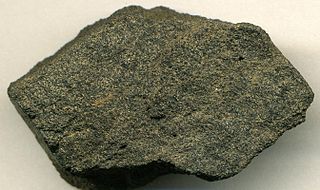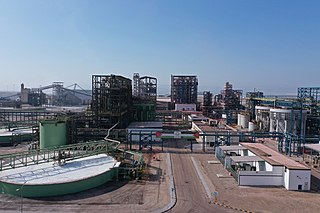
In chemistry, a phosphate is an anion, salt, functional group or ester derived from a phosphoric acid. It most commonly means orthophosphate, a derivative of orthophosphoric acid H
3PO
4.

Potash includes various mined and manufactured salts that contain potassium in water-soluble form. The name derives from pot ash, plant ashes or wood ash soaked in water in a pot, the primary means of manufacturing potash before the Industrial Era. The word potassium is derived from potash.

Agrium was a major retail supplier of agricultural products and services in North America, South America and Australia and a wholesale producer and marketer of all three major agricultural nutrients and a supplier of specialty fertilizers in North America.

Codelco is a Chilean state-owned copper mining company. It was formed in 1976 from foreign-owned copper companies that were nationalised in 1971.

Phosphorite, phosphate rock or rock phosphate is a non-detrital sedimentary rock that contains high amounts of phosphate minerals. The phosphate content of phosphorite (or grade of phosphate rock) varies greatly, from 4% to 20% phosphorus pentoxide (P2O5). Marketed phosphate rock is enriched ("beneficiated") to at least 28%, often more than 30% P2O5. This occurs through washing, screening, de-liming, magnetic separation or flotation. By comparison, the average phosphorus content of sedimentary rocks is less than 0.2%. The phosphate is present as fluorapatite Ca5(PO4)3F typically in cryptocrystalline masses (grain sizes < 1 μm) referred to as collophane-sedimentary apatite deposits of uncertain origin. It is also present as hydroxyapatite Ca5(PO4)3OH or Ca10(PO4)6(OH)2, which is often dissolved from vertebrate bones and teeth, whereas fluorapatite can originate from hydrothermal veins. Other sources also include chemically dissolved phosphate minerals from igneous and metamorphic rocks. Phosphorite deposits often occur in extensive layers, which cumulatively cover tens of thousands of square kilometres of the Earth's crust.

The Potash Corporation of Saskatchewan, also known as PotashCorp, was a company based in Saskatoon, Saskatchewan. The company merged with Calgary-based Agrium to form Nutrien, in a transaction that closed on January 1, 2018.

The OCP Group is a Moroccan state-owned phosphate rock miner, phosphoric acid manufacturer and fertilizer producer. Founded in 1920, the company has grown to become the world's largest "supermajor" producer of phosphate and phosphate-based products and it is one of the largest phosphate, fertilizer, Chemicals and Mineral industrial companies in the world by revenue.

Mining in Iran is still under development, yet the country is one of the most important mineral producers in the world, ranked among 15 major mineral-rich countries, holding some 68 types of minerals, 37 billion tonnes of proven reserves and more than 57 billion tonnes of potential reserves worth $770 billion in 2014. Mineral production contributes only 0.6 per cent to the country's GDP. Add other mining-related industries and this figure increases to just four per cent (2005). Many factors have contributed to this, namely lack of suitable infrastructure, legal barriers, exploration difficulties, and government control.

The Arab Potash Company (APC) is a company that is primarily involved in harvesting minerals from the Dead Sea. It is the eighth largest potash producer worldwide by volume of production and the sole Arab producer of potash. The company was formed in 1956 in the Hashemite Kingdom of Jordan as a pan-Arab business venture and it has a 100-year concession (1958-2058) from the government of Jordan that grants it exclusive rights to extract, manufacture and market minerals from the Dead Sea. It is headquartered in Amman and has its main plants at Ghor Al Safi. The company's stock is listed on the Amman Stock Exchange's ASE Weighted Index.
Jordan Phosphate Mines (JPMC) is a mining company based in Amman, Jordan. The company operates 3 mining facilities in Jordan and a chemical manufacturing complex in Aqaba. The company is listed on the Amman Stock Exchange's ASE Weighted Index as "JOPH".
The mineral industry of Russia is one of the world's leading mineral industries and accounts for a large percentage of the Commonwealth of Independent States' production of a range of mineral products, including metals, industrial minerals, and mineral fuels. In 2005, Russia ranked among the leading world producers or was a significant producer of a vast range of mineral commodities, including aluminum, arsenic, cement, copper, magnesium compounds and metals, nitrogen, palladium, silicon, nickel and vanadium.

SAG/SDAG Wismut was a uranium mining company in East Germany during the time of the Cold War. It produced a total of 230,400 tonnes of uranium between 1947 and 1990 and made East Germany the fourth largest producer of uranium ore in the world at the time. It was the largest single producer of uranium ore in the entire sphere of control of the USSR. In 1991 after German reunification it was transformed into the Wismut GmbH company, owned by the Federal Republic of Germany, which is now responsible for the restoration and environmental cleanup of the former mining and milling areas. The head office of SDAG Wismut / Wismut GmbH is in Chemnitz-Siegmar.
Allkem Limited, known as Orocobre Limited until 30 November 2021, is a mineral resource company based in Brisbane, Australia. The company's present focus is on lithium and borax mining operations within Argentina. Since 2007 Orocobre Ltd. is registered at the Australian Securities Exchange ASX and as of 2010 listed on the TSX. The company is included in the S&P/ASX 300 Index.

Mining in the United Kingdom produces a wide variety of fossil fuels, metals, and industrial minerals due to its complex geology. In 2013, there were over 2,000 active mines, quarries, and offshore drilling sites on the continental land mass of the United Kingdom producing £34bn of minerals and employing 36,000 people.
EuroChem Group AG is a Swiss fertilizer producer. It is a fertilizer manufacturer with its own capacity in all three primary nutrients – nitrogen, phosphates and potash. It is headquartered in Zug, Switzerland.
Cominco Resources is a private company which is developing the US$2billion Hinda phosphate project located in The Republic of the Congo. Through its subsidiary it owns 100% of the Hinda Phosphate Project, which comprises the Hinda Permit, and the Kolatchikanou Permit. The Hinda project is the world's largest undeveloped phosphate deposit with a JORC Mineral Resource of 678 Mt and a Minable Ore Reserve of 405 Mt, sufficient for over 24 years of production. Cominco Resources was merged with Kropz in December 2018 and listed on the AIM market.
The Abu Tartur mine is a large proposed mine located in New Valley Governorate. Abu Tartur represents one of the largest phosphates reserve in Egypt having estimated reserves of 980 million tonnes of ore grading 30% P2O5.
The Udon North Mine is a large potash mine in northern Thailand in Udon Thani Province. The project is approximately 15-20 kilometres southeast of the city of Udon Thani. The project area, including Udon South Mine, covers five sub-districts including Non Sung, Nong Phai, and Nong Khon Kwang of Mueang Udon Thani District together with Huai Sam Phat and Na Muang Sub-districts of Prachaksinlapakhom District. Northeast Thailand is believed to contain the world's third-largest—after Canada and Russia—unexploited potash reserves.
In 2015, 27.6 million metric tons of marketable phosphate rock, or phosphorite, was mined in the United States, making the US the world's third-largest producer, after China and Morocco. The phosphate mining industry employed 2,200 people. The value of phosphate rock mined was US$2.2 billion.

Nutrien is a Canadian fertilizer company based in Saskatoon, Saskatchewan. It is the largest producer of potash and the third largest producer of nitrogen fertilizer in the world. It has over 2,000 retail locations across North America, South America, and Australia with more than 23,500 employees. It is listed on the Toronto Stock Exchange and New York Stock Exchange, with a market capitalization of $34 billion as of January 2018. It was formed through the merger of PotashCorp and Agrium, in a transaction that closed on January 1, 2018.












